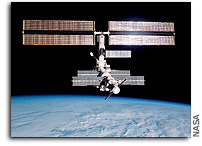NASA Space Station On-Orbit Status 5 June 2005

SpaceRef note: This NASA Headquarters internal status report, as presented here, contains additional, original material produced by SpaceRef.com (copyright © 2005) to enhance access to related status reports and NASA activities.
All ISS systems continue to function nominally, except those noted previously or below. Sunday — off-duty day for Sergei Krikalev & John Phillips, except for some housekeeping and voluntary tasks. Ahead: Week 7 for Increment 11.
As part of regular morning inspection after wakeup, CDR Krikalev checked up on a fluid connector of the urine collection system in the Service Module (SM) behind panel 139, looking for moisture.
FE/SO Phillips completed the daily routine maintenance of the SM’s SOZh environment control & life support system, today including the weekly collection of the toilet flush (SP) counter and water supply (SVO) readings for calldown to TsUP/Moscow.
|
Shuttle |
At his discretion for today, Krikalev worked two tasks from the “job jar” work list. He first conducted another session with the “Uragan” (hurricane) earth-imaging program, focusing the Nikon D1X No. 3 digital camera with 800-mm lens on targets called out on an uplinked list. [Today’s targets included scenic shots of Byelorussia, the Chernobyl power plant, western suburb of Oryol, a series of detailed overlapping images of farm fields south of Kursk, detailed imagery of fields in Voronezh Region and of Central Russia, a large island on the Volga River directly at nadir, the city of Tashkent and the mountain valley east of the city, mountain range foothills surrounding the Fergana Valley, large glaciers descending from Lenin Peak and to the west of the Fedchenko glacier, the Taman Peninsula near the strait of Kerch, forest clearances in the mountains of the Krasnodar Region, the Pyatigorsk environs, detailed test imagery of Vladikavkaz, the high-altitude areas of Chechnya and Dagestan, the Artyom Island connected to Baku by the overpass in the north-eastern part of Apsheron, Turkmeniya mountains, etc.]
As a second “job jar” suggestion, the CDR conducted the regular daily inspection of the BIO-5 Rasteniya-2 experiment, including filling its water canister as required. [Rasteniya (“plants”) researches growth and development of plants (currently horse radish) under spaceflight conditions in the Lada-7 greenhouse.]
Both crewmembers conducted their regular 2.5-hr. physical exercise program on the TVIS treadmill, RED resistive machine and VELO bike with bungee cord load trainer. [Sergei’s daily protocol prescribes a strict four-day microcycle exercise with 1.5 hr on the treadmill and one hour on VELO plus load trainer (today: Day 1 of a new set).]
No CEO (crew earth observations) photo targets today.
CEO photography can be viewed and studied at the websites:
- http://eol.jsc.nasa.gov
- http://earthobservatory.nasa.gov
- http://earthobservatory.nasa.gov/Study/AstronautPhotography/
See also the website “Space Station Challenge” at:
To view the latest photos taken by the expedition 11 crew visit:
- http://spaceflight.nasa.gov/gallery/images/station/crew-11/ndxpage1.html at NASA’s Human Spaceflight website.
Expedition 11 Flight Crew Plans can be found at http://spaceflight.nasa.gov/station/timelines/
Previous NASA ISS On-orbit Status Reports can be found here. Previous NASA Space Station Status Reports can be found here. Previous NASA Space Shuttle Processing Status Reports can be found here. A collection of all of these reports and other materials relating to Return to Flight for the Space Shuttle fleet can be found here.
|
|
ISS Orbit (as of this morning, 10:49am EDT [= epoch]):
- Mean altitude — 351.7 km
- Apogee height — 354.9 km
- Perigee height — 348.5 km
- Period — 91.57 min.
- Inclination (to Equator) — 51.65 deg
- Eccentricity — 0.0004767
- Solar Beta Angle — -25.8 deg (magnitude decreasing)
- Orbits per 24-hr. day — 15.72
- Mean altitude loss in last 24 hours — 100
- Revolutions since FGB/Zarya launch (Nov. 98) – 37386
Some Increment 11 Main Events (not final):
- Progress M-52 (17P) undock — 6/15 (4:13pm EDT);
- Progress M-53 (18P) launch — 6/16 (7:09pm EDT, Baikonur: 6/17, 5:09am)
- Progress M-53 (18P) dock — 6/18 (8:46pm EDT);
- Reboost — ~6/22 (delta-V 1.5 m/s);
- LF-1/STS-114 launch — 7/13 (18-day window opens);
- Soyuz TMA-6 (10S) relocate (from DC-1 to FGB) — ~8/16;
- Progress M-54 (19P) launch — 8/24 (dock 8/26);
- ULF1.1/STS-121 launch — NET 9/9 (launch window opens);
- 12A/STS-115 launch — NET 2/16/06;
- 12A.1/STS-116 launch — NET 4/23/06;
- 13A/STS-117 launch — NET 5/18/06.
ISS Altitude History
Apogee height — Mean Altitude — Perigee height

For more on ISS orbit and worldwide ISS naked-eye visibility dates/times, see http://www.hq.nasa.gov/osf/station/viewing/issvis.html. In addition, information on International Space Station sighting opportunities can be found at http://spaceflight.nasa.gov/realdata/sightings/ on NASA’s Human Spaceflight website. The current location of the International Space Station can be found at http://science.nasa.gov/temp/StationLoc.html at NASA’s Marshall Space Flight Center. Additional satellite tracking resources can be found at http://www.spaceref.com/iss/tracking.html.









